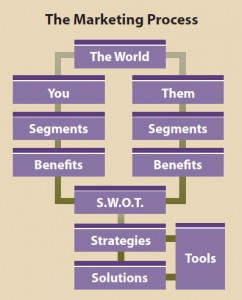Breaking New Ground – Step by Step
Our Marketing Process Model

No one knows your business better than you do. But there’s always room to learn more.
The most important part of our service process is our recognition that marketing, first and foremost, is a learning process. We may not have all the answers when you first meet us, but we can promise you good questions: the kind of questions that help you see your opportunities in a fresh light.We’ll also take our questions to anyone else who might have useful answers. Industry analysts and trade publishers, your dealers and suppliers and your customers can all help us to rise up the learning curve.
Our overriding question, of course, is this:
How can we help you achieve your business goals?
Work with us, and we’ll leave no stone unturned to root out the answers we need to create breakthrough communications that are right on target with your business goals. In the process, you may even learn something more about yourself!
Our approach is really very simple: 3 steps to make us an effective partner to your marketing process:
Step 1.Understand your marketing world.
Step 2.Develop practical strategies to achieve your objectives.
Step 3.Implement creative solutions that will make a positive difference.
Ready?
The following pages expand on some of the thinking that makes this model work. We hope it will help you to learn more about how integrated communications can have a vital role in growing success for your business.
When you’re ready move forward, count Marketing Strategies & Solutions among your assets and allies. We’re ready to work through the complete process with you and your team, and turn your plan into results.
1. THE WORLD
Players · Barriers · Economics · Politics · Technologies · Attitudes · Trends
Think about the whole scope of your business world and who’s in it. Who or what are the leading forces? What are the key factors that promote (or limit) growth in your industry? What are the key trends today? How are you affected by innovation?
YOU
People · Products · Processes · Perceptions
Get to know yourself – defi ne the character and assets of your business based on the people you rely on, the range and position of your products, the technologies you deploy. What makes you special in terms of the way you relate to customers and suppliers? How is your company regarded by employees, associates, your industry and consumers at large?
Segments
Location · Demographics · Usage · Habits · Risks
Different needs, different ways, different channels – understanding differences is the key to “person to person” communications. Think of the other different needs of different customers, and think of all the other stakeholders who have a role in your success? Which differences affect purchasing decisions and help to identify unique groups with potential for growth?
Benefi ts
Primary · Secondary · Basic · Different
What does your business really do for customers and stakeholders? Consider all the benefi ts that various customers derive: how does the package of benefi ts differ between various market segments and audiences?
Which benefi ts are essential values for your product category or service? Which benefi ts provide an “extra” value beyond the basics? Which ones are common in your competitive arena? Which benefi ts are unique to your offering?
THEM
Segments · Benefi ts
As above!
Know your competitors as well as you know yourself. Recognize what things they do well, and what gives them an advantage! How do they specialize differently? What kind of strategies do they seem to favour?
S.W.O.T
Strengths · Weaknesses · Opportunities · Threats
Once you understand as much as possible about your business world, start comparing notes: weigh your strengths against the competition and identify relative weaknesses. Look at new trends and changes in the market that can mean fresh opportunities for you or for competitors. Recognize threats you are likely to face, so you can prepare an effective defense.
2. STRATEGIES
Objectives · Branding · Product Positioning · Budgets · Targets & Tactics
Turn your SWOT into an action plan by identifying goals that build on your strengths and counter the threats you face. Consider how your brand strengths and product advantages can work together to support your goals. Chart your path to success with specifi c communications objectives and set budgets that refl ect what the success of each campaign will be worth to your business Finally, outline specifi c programs to deliver the right marketing message to the right people at the right time.
3. SOLUTIONS
Creative Concepts · Media Planning · Project Management · Research
Once you know where you’re going and how you plan to get there, you can begin packaging your communications to break through to your audience with imagination and effi ciency.Look for opportunities to have programs complement and reinforce each other. Keep your brand character “top-of-mind” mind as you evaluate alternative approaches – it’s the foundation for all your future success. Then… follow up! What have you achieved? Where do you go from here
TOOLS
Corporate Identity · Advertising · Sales Promotion · Direct Response · Special Events Media Relations · Multimedia · Packaging · Online Marketing
Choosing the right tool starts with knowing the job you have to do. Let strategy guide your tactics. Don’t base your communications on “the way we’ve always done this” in the past. Don’t make your plan a mirror of what your competition is doing. And don’t limit your thinking to the tools we have listed here. If the best way to deliver your story is to write chalk messages on the sidewalk, go for it! Keep an open mind – you’re breaking new ground
At the completion of this process, remember: this is just the beginning. Revisit and revise your plans often.
Things change – if you aren’t making a difference, you aren’t making progress!
Let us show you how, contact us today.

